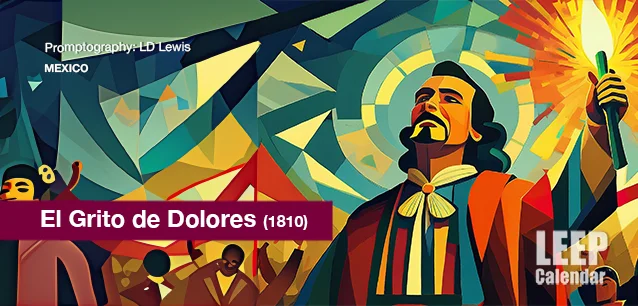 AD
AD
Today is: November 24
Scroll to explore events active on this date.
Additional Events on LEEP
LEEP INK FEATURES

Nuanced November 2024
November is the start of the holiday season in many parts of the world. It is a time for family, football, food, shopping and decorating, particularly in the Christian and Jewish world, leading to Christmas and...

December's Gift
Events in December 2024. Well, we made it to December. December is the holiday season, particularly in Western nations, where Christianity and Judaism are the faiths most common in the nation's past. ...

August is Appropos
A toddler playing in the fountain at a park in Santa Fe, New Mexico—Photo LD Lewis. In August, we live through the Dog Days of Summer. It's hot and often humid, and those ...
About Mexico's Grito de Dolores (Cry of Dolores)
Civil Rights , Mexico & Central America
Ends: Sep 15, 2025
DESCRIPTION:
INDEPENDENCE BEGINS WITH A SHOUT
EL GRITO DE DOLORES IN MEXICO
Grito de Dolores is a pivotal event in Mexican history, marking the beginning of the country's struggle for independence from Spanish rule. Celebrated annually on the night of September 15 into the early hours of September 16, this holiday commemorates the moment in 1810 when Miguel Hidalgo y Costilla, a Catholic priest, called for rebellion against the Spanish authorities. This call is famously known as the "Grito de Dolores" or "Cry of Dolores."
Grito de Dolores celebrates the start of the Mexican War of Independence. It honors the courage and determination of the Mexican people who sought to free themselves from colonial oppression. The event is both a patriotic celebration and a moment of reflection on the nation's history and the values of freedom and justice.
The celebrations begin on the evening of September 15, when the President of Mexico reenacts the famous cry from the balcony of the National Palace in Mexico City. This act, known as "El Grito," involves ringing a bell and shouting, "¡Viva México!" and "¡Viva la independencia!" The crowd responds with enthusiastic cheers. This tradition is mirrored in towns and cities nationwide, with local officials performing similar ceremonies.
The festivities continue with fireworks, music, parades, and traditional foods. The atmosphere is one of national pride, and people often dress in the colors of the Mexican flag—green, white, and red.
HISTORY OF THE EVENT
The original "Grito de Dolores" occurred in the town of Dolores (now Dolores Hidalgo) in the early hours of September 16, 1810. Father Miguel Hidalgo, who had grown increasingly disillusioned with Spanish rule and the exploitation of indigenous people, rang the church bell to gather his parishioners. He delivered a passionate speech urging them to rise against the Spanish, which ignited the fight for independence.
Hidalgo's cry is said to have included appeals to end Spanish domination and redistribute land. Though the exact words of the cry are debated, the essence of the message was a call to arms for Mexican independence. This event set off a series of battles and campaigns that ultimately led to Mexico's independence in 1821.
WHO IS DOLORES, AND WHY DID SHE CRY OUT?
The name "Dolores" refers to the town of Dolores, where Father Hidalgo made his call to arms. The town's name translates to "sorrows" or "pains" in English, but in this context, it doesn't refer to a person named Dolores but instead to the town itself. The "cry" was a symbolic call for action against the injustices and suffering imposed by colonial rule.
The Grito de Dolores symbolizes resistance and the enduring spirit of the Mexican people. It is a critical moment in Mexican history and a deeply ingrained cultural tradition that continues to unite the nation in a shared identity and purpose.
VIDEOS
SUPPORTING DOCUMENTS
Currently, this event does not have supporting documents.
ADDITIONAL IMAGES
Currently, this event does not have supporting images.
Where would you like to go now?
 AD
AD


/footer-logo.svg)
